Analyzing Biological and Social Influences on Adolescent Development
VerifiedAdded on 2023/06/18
|8
|2581
|69
Essay
AI Summary
This essay delves into the adolescent stage of development, highlighting the significant physical and psychosocial changes that occur between the ages of 10 and 19. It emphasizes the importance of biological and social factors in shaping a child's growth, behavior, and decision-making. The essay discusses how biological elements such as genetics, nutrition, and hormonal changes interact with social influences like family expectations, peer relationships, cultural background, and media to impact adolescent development. Models like social motivation, reward sensitivity, and distraction are explored to understand how social influences affect decision-making during adolescence. The essay concludes that a supportive social environment combined with proper biological care is crucial for fostering healthy development and responsible behavior in adolescents.
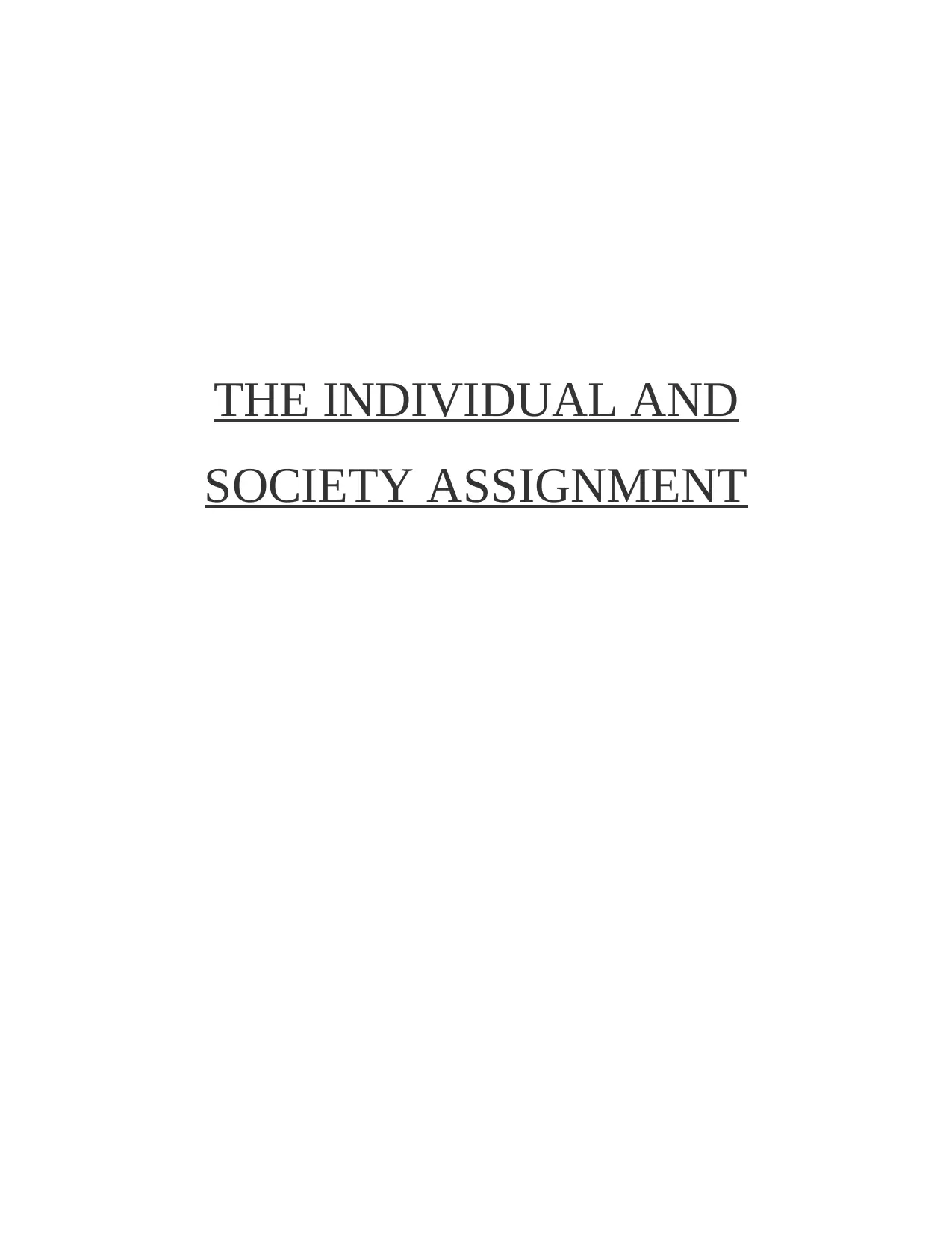
THE INDIVIDUAL AND
SOCIETY ASSIGNMENT
SOCIETY ASSIGNMENT
Paraphrase This Document
Need a fresh take? Get an instant paraphrase of this document with our AI Paraphraser
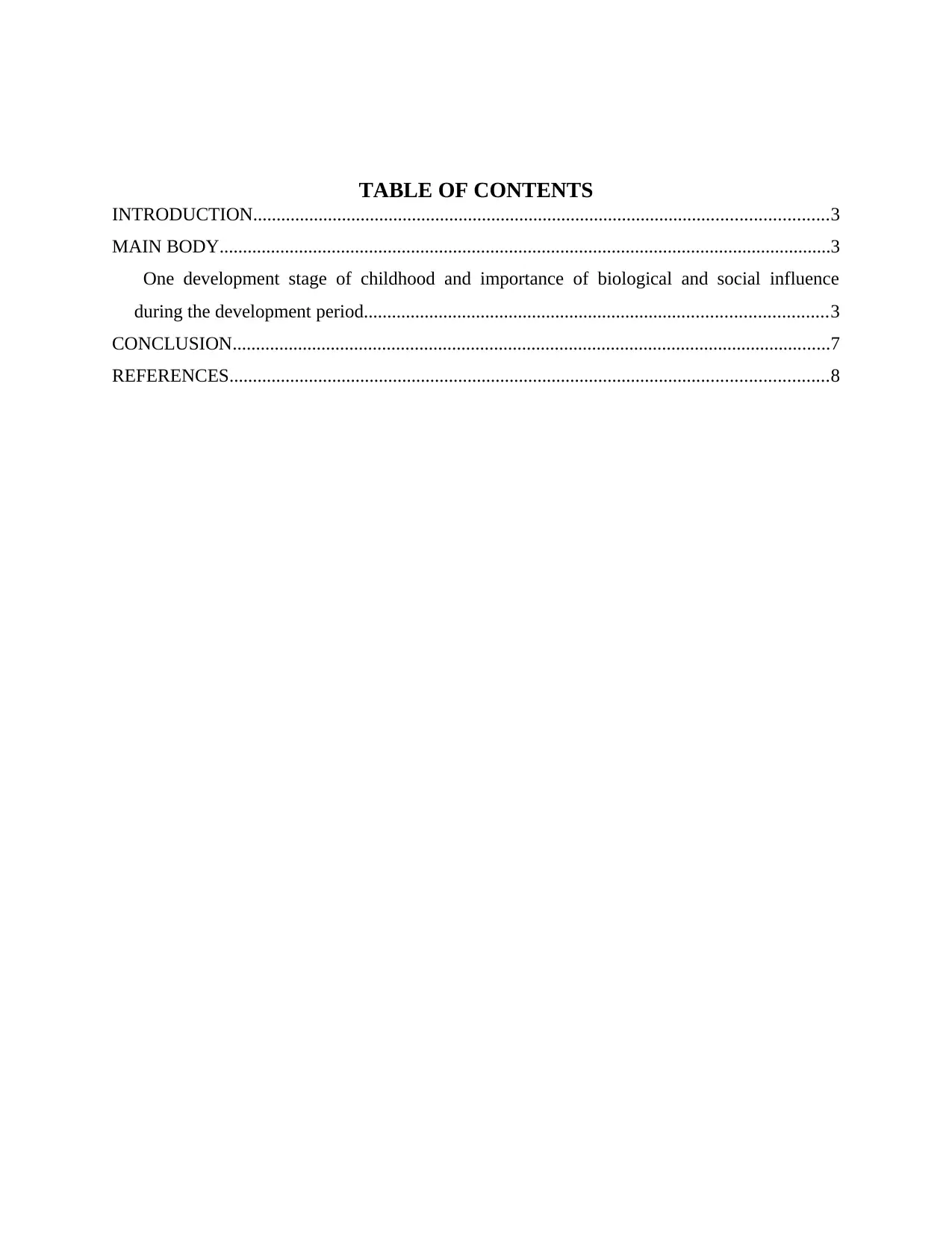
TABLE OF CONTENTS
INTRODUCTION...........................................................................................................................3
MAIN BODY...................................................................................................................................3
One development stage of childhood and importance of biological and social influence
during the development period...................................................................................................3
CONCLUSION................................................................................................................................7
REFERENCES................................................................................................................................8
INTRODUCTION...........................................................................................................................3
MAIN BODY...................................................................................................................................3
One development stage of childhood and importance of biological and social influence
during the development period...................................................................................................3
CONCLUSION................................................................................................................................7
REFERENCES................................................................................................................................8
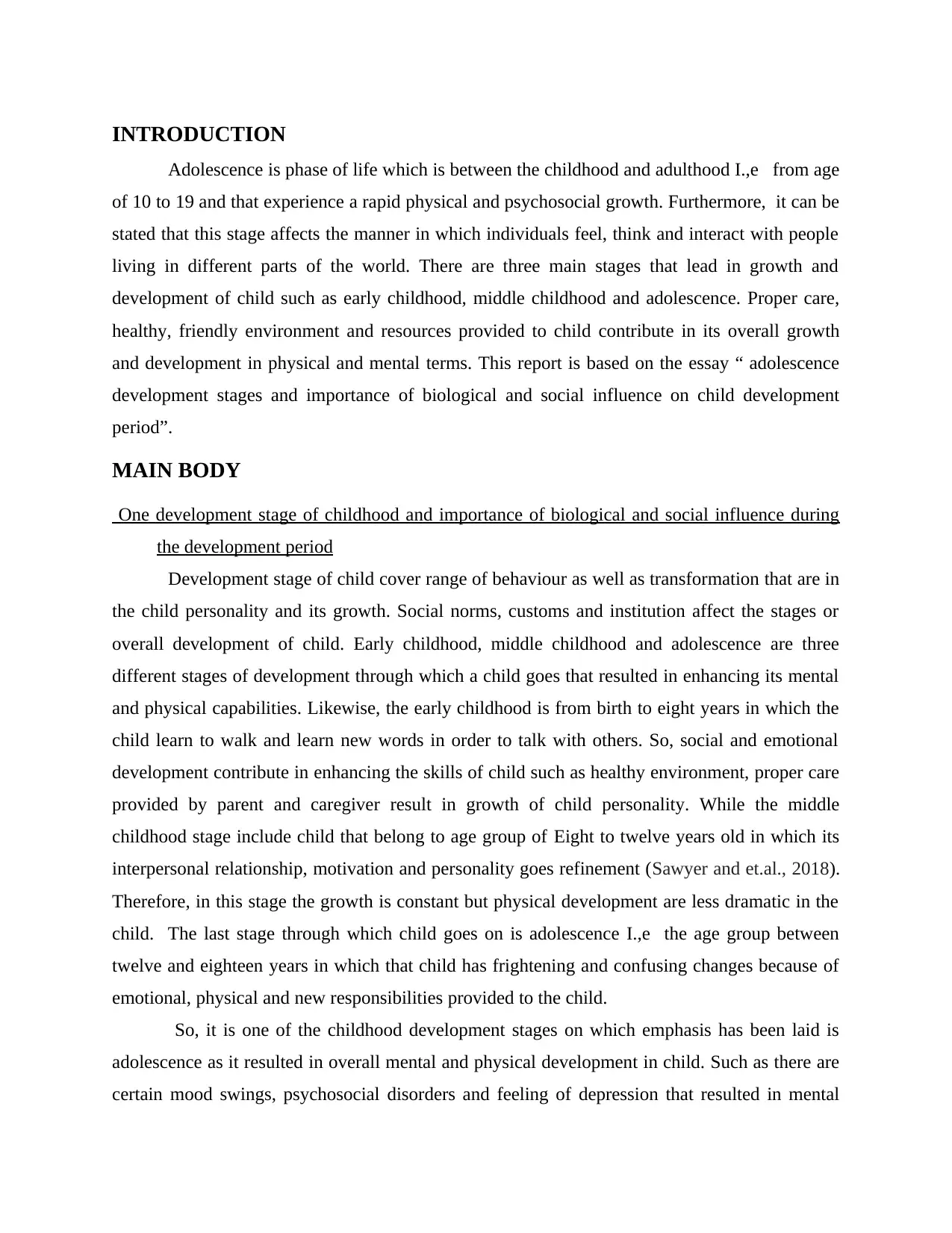
INTRODUCTION
Adolescence is phase of life which is between the childhood and adulthood I.,e from age
of 10 to 19 and that experience a rapid physical and psychosocial growth. Furthermore, it can be
stated that this stage affects the manner in which individuals feel, think and interact with people
living in different parts of the world. There are three main stages that lead in growth and
development of child such as early childhood, middle childhood and adolescence. Proper care,
healthy, friendly environment and resources provided to child contribute in its overall growth
and development in physical and mental terms. This report is based on the essay “ adolescence
development stages and importance of biological and social influence on child development
period”.
MAIN BODY
One development stage of childhood and importance of biological and social influence during
the development period
Development stage of child cover range of behaviour as well as transformation that are in
the child personality and its growth. Social norms, customs and institution affect the stages or
overall development of child. Early childhood, middle childhood and adolescence are three
different stages of development through which a child goes that resulted in enhancing its mental
and physical capabilities. Likewise, the early childhood is from birth to eight years in which the
child learn to walk and learn new words in order to talk with others. So, social and emotional
development contribute in enhancing the skills of child such as healthy environment, proper care
provided by parent and caregiver result in growth of child personality. While the middle
childhood stage include child that belong to age group of Eight to twelve years old in which its
interpersonal relationship, motivation and personality goes refinement (Sawyer and et.al., 2018).
Therefore, in this stage the growth is constant but physical development are less dramatic in the
child. The last stage through which child goes on is adolescence I.,e the age group between
twelve and eighteen years in which that child has frightening and confusing changes because of
emotional, physical and new responsibilities provided to the child.
So, it is one of the childhood development stages on which emphasis has been laid is
adolescence as it resulted in overall mental and physical development in child. Such as there are
certain mood swings, psychosocial disorders and feeling of depression that resulted in mental
Adolescence is phase of life which is between the childhood and adulthood I.,e from age
of 10 to 19 and that experience a rapid physical and psychosocial growth. Furthermore, it can be
stated that this stage affects the manner in which individuals feel, think and interact with people
living in different parts of the world. There are three main stages that lead in growth and
development of child such as early childhood, middle childhood and adolescence. Proper care,
healthy, friendly environment and resources provided to child contribute in its overall growth
and development in physical and mental terms. This report is based on the essay “ adolescence
development stages and importance of biological and social influence on child development
period”.
MAIN BODY
One development stage of childhood and importance of biological and social influence during
the development period
Development stage of child cover range of behaviour as well as transformation that are in
the child personality and its growth. Social norms, customs and institution affect the stages or
overall development of child. Early childhood, middle childhood and adolescence are three
different stages of development through which a child goes that resulted in enhancing its mental
and physical capabilities. Likewise, the early childhood is from birth to eight years in which the
child learn to walk and learn new words in order to talk with others. So, social and emotional
development contribute in enhancing the skills of child such as healthy environment, proper care
provided by parent and caregiver result in growth of child personality. While the middle
childhood stage include child that belong to age group of Eight to twelve years old in which its
interpersonal relationship, motivation and personality goes refinement (Sawyer and et.al., 2018).
Therefore, in this stage the growth is constant but physical development are less dramatic in the
child. The last stage through which child goes on is adolescence I.,e the age group between
twelve and eighteen years in which that child has frightening and confusing changes because of
emotional, physical and new responsibilities provided to the child.
So, it is one of the childhood development stages on which emphasis has been laid is
adolescence as it resulted in overall mental and physical development in child. Such as there are
certain mood swings, psychosocial disorders and feeling of depression that resulted in mental
⊘ This is a preview!⊘
Do you want full access?
Subscribe today to unlock all pages.

Trusted by 1+ million students worldwide
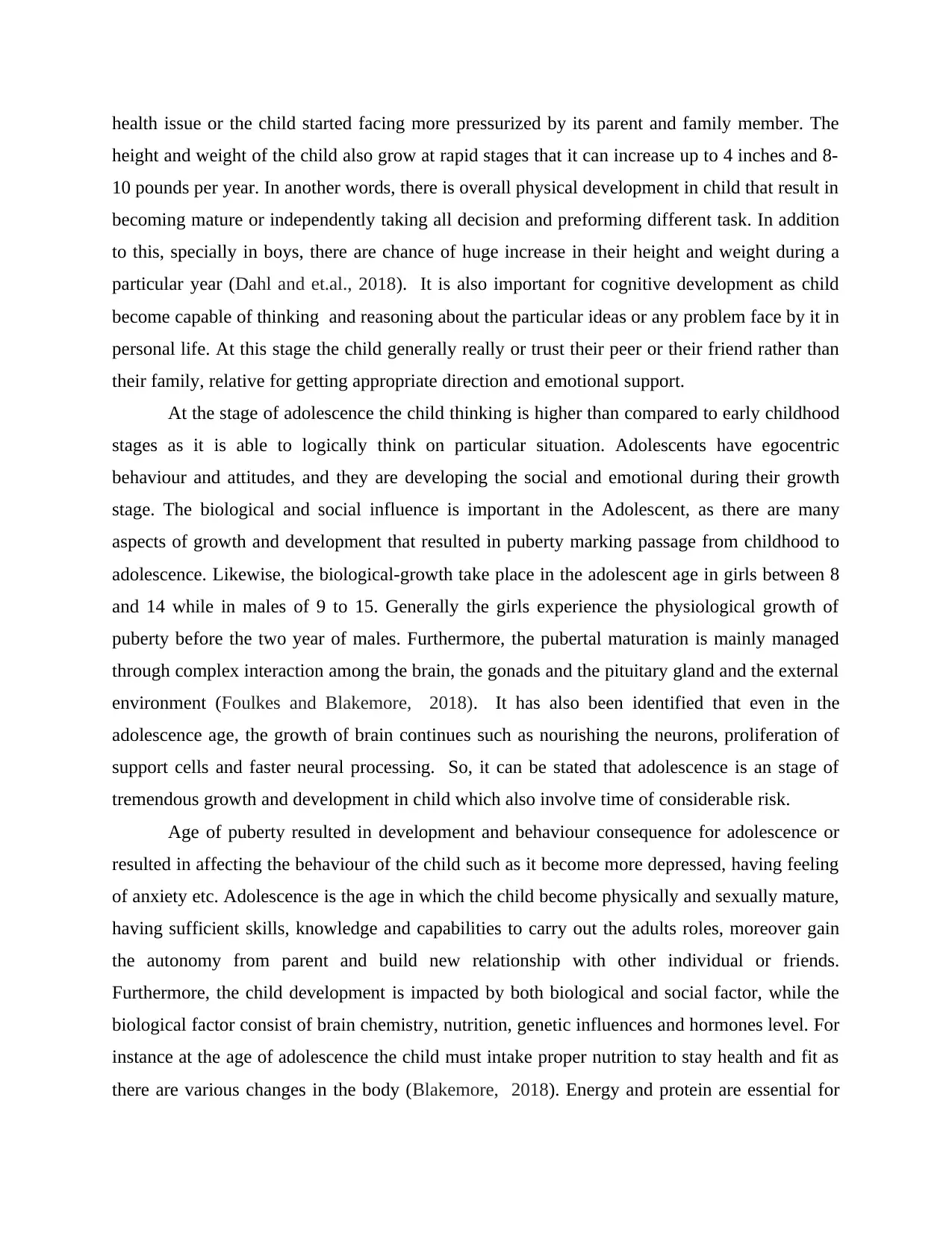
health issue or the child started facing more pressurized by its parent and family member. The
height and weight of the child also grow at rapid stages that it can increase up to 4 inches and 8-
10 pounds per year. In another words, there is overall physical development in child that result in
becoming mature or independently taking all decision and preforming different task. In addition
to this, specially in boys, there are chance of huge increase in their height and weight during a
particular year (Dahl and et.al., 2018). It is also important for cognitive development as child
become capable of thinking and reasoning about the particular ideas or any problem face by it in
personal life. At this stage the child generally really or trust their peer or their friend rather than
their family, relative for getting appropriate direction and emotional support.
At the stage of adolescence the child thinking is higher than compared to early childhood
stages as it is able to logically think on particular situation. Adolescents have egocentric
behaviour and attitudes, and they are developing the social and emotional during their growth
stage. The biological and social influence is important in the Adolescent, as there are many
aspects of growth and development that resulted in puberty marking passage from childhood to
adolescence. Likewise, the biological-growth take place in the adolescent age in girls between 8
and 14 while in males of 9 to 15. Generally the girls experience the physiological growth of
puberty before the two year of males. Furthermore, the pubertal maturation is mainly managed
through complex interaction among the brain, the gonads and the pituitary gland and the external
environment (Foulkes and Blakemore, 2018). It has also been identified that even in the
adolescence age, the growth of brain continues such as nourishing the neurons, proliferation of
support cells and faster neural processing. So, it can be stated that adolescence is an stage of
tremendous growth and development in child which also involve time of considerable risk.
Age of puberty resulted in development and behaviour consequence for adolescence or
resulted in affecting the behaviour of the child such as it become more depressed, having feeling
of anxiety etc. Adolescence is the age in which the child become physically and sexually mature,
having sufficient skills, knowledge and capabilities to carry out the adults roles, moreover gain
the autonomy from parent and build new relationship with other individual or friends.
Furthermore, the child development is impacted by both biological and social factor, while the
biological factor consist of brain chemistry, nutrition, genetic influences and hormones level. For
instance at the age of adolescence the child must intake proper nutrition to stay health and fit as
there are various changes in the body (Blakemore, 2018). Energy and protein are essential for
height and weight of the child also grow at rapid stages that it can increase up to 4 inches and 8-
10 pounds per year. In another words, there is overall physical development in child that result in
becoming mature or independently taking all decision and preforming different task. In addition
to this, specially in boys, there are chance of huge increase in their height and weight during a
particular year (Dahl and et.al., 2018). It is also important for cognitive development as child
become capable of thinking and reasoning about the particular ideas or any problem face by it in
personal life. At this stage the child generally really or trust their peer or their friend rather than
their family, relative for getting appropriate direction and emotional support.
At the stage of adolescence the child thinking is higher than compared to early childhood
stages as it is able to logically think on particular situation. Adolescents have egocentric
behaviour and attitudes, and they are developing the social and emotional during their growth
stage. The biological and social influence is important in the Adolescent, as there are many
aspects of growth and development that resulted in puberty marking passage from childhood to
adolescence. Likewise, the biological-growth take place in the adolescent age in girls between 8
and 14 while in males of 9 to 15. Generally the girls experience the physiological growth of
puberty before the two year of males. Furthermore, the pubertal maturation is mainly managed
through complex interaction among the brain, the gonads and the pituitary gland and the external
environment (Foulkes and Blakemore, 2018). It has also been identified that even in the
adolescence age, the growth of brain continues such as nourishing the neurons, proliferation of
support cells and faster neural processing. So, it can be stated that adolescence is an stage of
tremendous growth and development in child which also involve time of considerable risk.
Age of puberty resulted in development and behaviour consequence for adolescence or
resulted in affecting the behaviour of the child such as it become more depressed, having feeling
of anxiety etc. Adolescence is the age in which the child become physically and sexually mature,
having sufficient skills, knowledge and capabilities to carry out the adults roles, moreover gain
the autonomy from parent and build new relationship with other individual or friends.
Furthermore, the child development is impacted by both biological and social factor, while the
biological factor consist of brain chemistry, nutrition, genetic influences and hormones level. For
instance at the age of adolescence the child must intake proper nutrition to stay health and fit as
there are various changes in the body (Blakemore, 2018). Energy and protein are essential for
Paraphrase This Document
Need a fresh take? Get an instant paraphrase of this document with our AI Paraphraser

pubertal development such as female require around 2200 of calories, while the male2500-3000
calories per day. So, proper intake of nutrition resulted in improving the health condition of the
child and lead in its overall development. Interaction among the biological and environment
factors also affect the development of child at adolescence stage, for example, an child inherited
height through genes but have not grown taller because of improper intake of nutrition by the
adult that is necessary for its overall health and well – being.
The importance of social influences on adolescence or last stage of child development is
that there are number of social factors that impact the decision-making of an adult. Social
motivation model, reward sensitivity model and distraction model that helps in understanding
two distinct neurodevelopmental explanations of altered decision-making during the phase of
adolescence. Social motivation verbal model lay emphasis importance on developing the “ Social
brain”. On the other hand, reward sensitivity and distraction focus on slow maturation of
cognitive control system (Worthman and Trang, 2018). Likewise, it can be stated that social
motivations model that considered that at adolescent age the child have increase social
motivation or influences by its peer, friend as compared to its family. They like to adapt or
change themselves as per the external environment or trends, fashion so that they can be look,
feel differentiate from others. Such as they are ready or more motivated to have innovative
products and services to satisfied their desire thus it influences them to be trendy.
While, reward sensitivity is another model that could be useful in understanding the
importance of social influences in context of child development age of adolescence. As per this
model, adolescence is the stage in which there is fast maturation of reward processing brain
coincide with slow maturity of cognitive control. So, the model clarified that biological
imbalance between the two system resulted in increasing risk of adolescent decision-making.
Distraction is another verbal model that also helps in understanding the manner adults are
influences to take decision related to their personal and professional life (Haraden, Mullin and
Hankin, 2017). Lack of self- control or concentration resulted in diminishing the cognitive skill
and showing more erratic or distracted behaviour in individual. Therefore, it is assumed that the
training related to mindfulness and meditation contribute in improving or promoting the positive
behaviour of individual in its adolescence age.
In addition to this, there are many other points which states the importance of social
influences on development of child in its adolescence age. Likewise, there are number of
calories per day. So, proper intake of nutrition resulted in improving the health condition of the
child and lead in its overall development. Interaction among the biological and environment
factors also affect the development of child at adolescence stage, for example, an child inherited
height through genes but have not grown taller because of improper intake of nutrition by the
adult that is necessary for its overall health and well – being.
The importance of social influences on adolescence or last stage of child development is
that there are number of social factors that impact the decision-making of an adult. Social
motivation model, reward sensitivity model and distraction model that helps in understanding
two distinct neurodevelopmental explanations of altered decision-making during the phase of
adolescence. Social motivation verbal model lay emphasis importance on developing the “ Social
brain”. On the other hand, reward sensitivity and distraction focus on slow maturation of
cognitive control system (Worthman and Trang, 2018). Likewise, it can be stated that social
motivations model that considered that at adolescent age the child have increase social
motivation or influences by its peer, friend as compared to its family. They like to adapt or
change themselves as per the external environment or trends, fashion so that they can be look,
feel differentiate from others. Such as they are ready or more motivated to have innovative
products and services to satisfied their desire thus it influences them to be trendy.
While, reward sensitivity is another model that could be useful in understanding the
importance of social influences in context of child development age of adolescence. As per this
model, adolescence is the stage in which there is fast maturation of reward processing brain
coincide with slow maturity of cognitive control. So, the model clarified that biological
imbalance between the two system resulted in increasing risk of adolescent decision-making.
Distraction is another verbal model that also helps in understanding the manner adults are
influences to take decision related to their personal and professional life (Haraden, Mullin and
Hankin, 2017). Lack of self- control or concentration resulted in diminishing the cognitive skill
and showing more erratic or distracted behaviour in individual. Therefore, it is assumed that the
training related to mindfulness and meditation contribute in improving or promoting the positive
behaviour of individual in its adolescence age.
In addition to this, there are many other points which states the importance of social
influences on development of child in its adolescence age. Likewise, there are number of
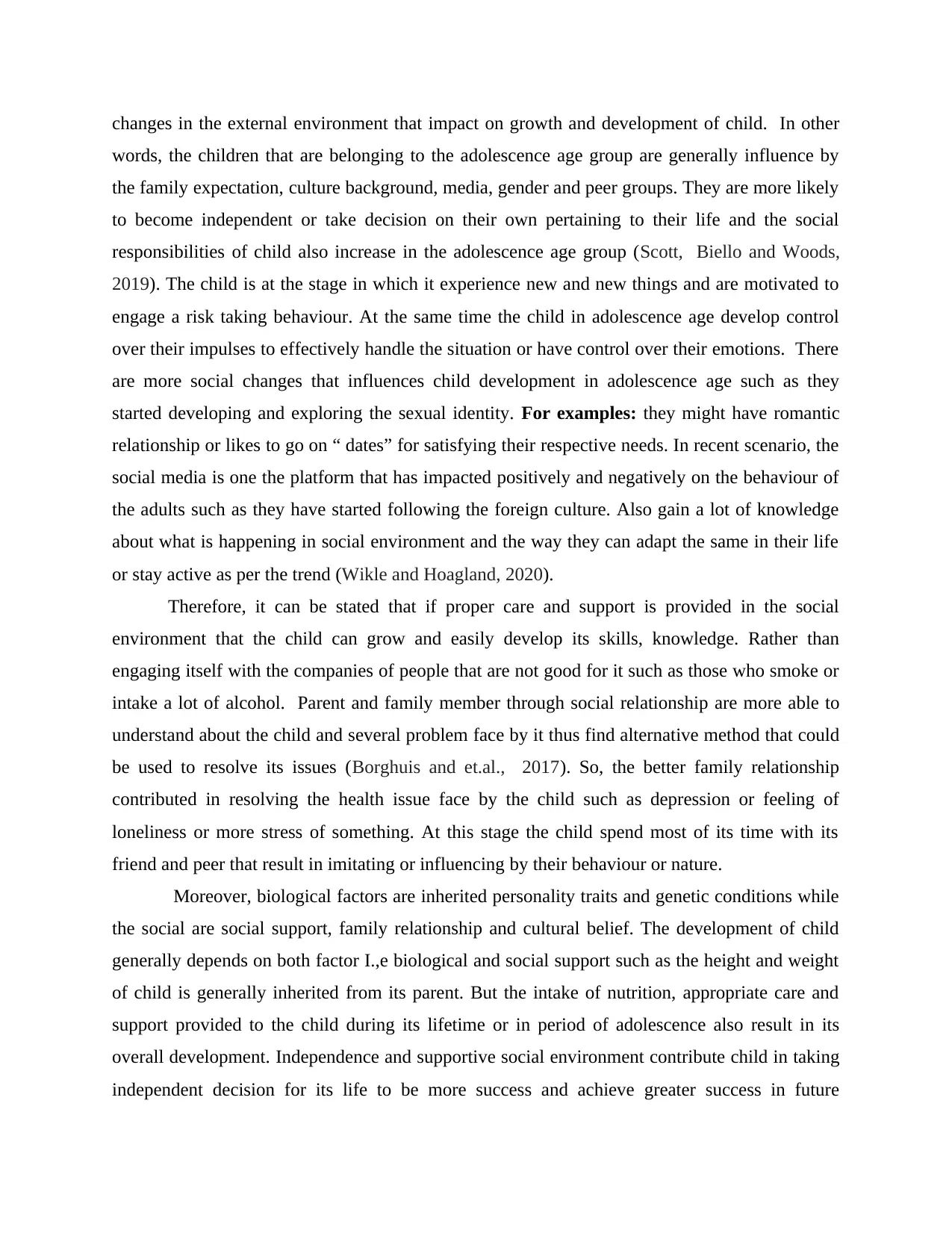
changes in the external environment that impact on growth and development of child. In other
words, the children that are belonging to the adolescence age group are generally influence by
the family expectation, culture background, media, gender and peer groups. They are more likely
to become independent or take decision on their own pertaining to their life and the social
responsibilities of child also increase in the adolescence age group (Scott, Biello and Woods,
2019). The child is at the stage in which it experience new and new things and are motivated to
engage a risk taking behaviour. At the same time the child in adolescence age develop control
over their impulses to effectively handle the situation or have control over their emotions. There
are more social changes that influences child development in adolescence age such as they
started developing and exploring the sexual identity. For examples: they might have romantic
relationship or likes to go on “ dates” for satisfying their respective needs. In recent scenario, the
social media is one the platform that has impacted positively and negatively on the behaviour of
the adults such as they have started following the foreign culture. Also gain a lot of knowledge
about what is happening in social environment and the way they can adapt the same in their life
or stay active as per the trend (Wikle and Hoagland, 2020).
Therefore, it can be stated that if proper care and support is provided in the social
environment that the child can grow and easily develop its skills, knowledge. Rather than
engaging itself with the companies of people that are not good for it such as those who smoke or
intake a lot of alcohol. Parent and family member through social relationship are more able to
understand about the child and several problem face by it thus find alternative method that could
be used to resolve its issues (Borghuis and et.al., 2017). So, the better family relationship
contributed in resolving the health issue face by the child such as depression or feeling of
loneliness or more stress of something. At this stage the child spend most of its time with its
friend and peer that result in imitating or influencing by their behaviour or nature.
Moreover, biological factors are inherited personality traits and genetic conditions while
the social are social support, family relationship and cultural belief. The development of child
generally depends on both factor I.,e biological and social support such as the height and weight
of child is generally inherited from its parent. But the intake of nutrition, appropriate care and
support provided to the child during its lifetime or in period of adolescence also result in its
overall development. Independence and supportive social environment contribute child in taking
independent decision for its life to be more success and achieve greater success in future
words, the children that are belonging to the adolescence age group are generally influence by
the family expectation, culture background, media, gender and peer groups. They are more likely
to become independent or take decision on their own pertaining to their life and the social
responsibilities of child also increase in the adolescence age group (Scott, Biello and Woods,
2019). The child is at the stage in which it experience new and new things and are motivated to
engage a risk taking behaviour. At the same time the child in adolescence age develop control
over their impulses to effectively handle the situation or have control over their emotions. There
are more social changes that influences child development in adolescence age such as they
started developing and exploring the sexual identity. For examples: they might have romantic
relationship or likes to go on “ dates” for satisfying their respective needs. In recent scenario, the
social media is one the platform that has impacted positively and negatively on the behaviour of
the adults such as they have started following the foreign culture. Also gain a lot of knowledge
about what is happening in social environment and the way they can adapt the same in their life
or stay active as per the trend (Wikle and Hoagland, 2020).
Therefore, it can be stated that if proper care and support is provided in the social
environment that the child can grow and easily develop its skills, knowledge. Rather than
engaging itself with the companies of people that are not good for it such as those who smoke or
intake a lot of alcohol. Parent and family member through social relationship are more able to
understand about the child and several problem face by it thus find alternative method that could
be used to resolve its issues (Borghuis and et.al., 2017). So, the better family relationship
contributed in resolving the health issue face by the child such as depression or feeling of
loneliness or more stress of something. At this stage the child spend most of its time with its
friend and peer that result in imitating or influencing by their behaviour or nature.
Moreover, biological factors are inherited personality traits and genetic conditions while
the social are social support, family relationship and cultural belief. The development of child
generally depends on both factor I.,e biological and social support such as the height and weight
of child is generally inherited from its parent. But the intake of nutrition, appropriate care and
support provided to the child during its lifetime or in period of adolescence also result in its
overall development. Independence and supportive social environment contribute child in taking
independent decision for its life to be more success and achieve greater success in future
⊘ This is a preview!⊘
Do you want full access?
Subscribe today to unlock all pages.

Trusted by 1+ million students worldwide
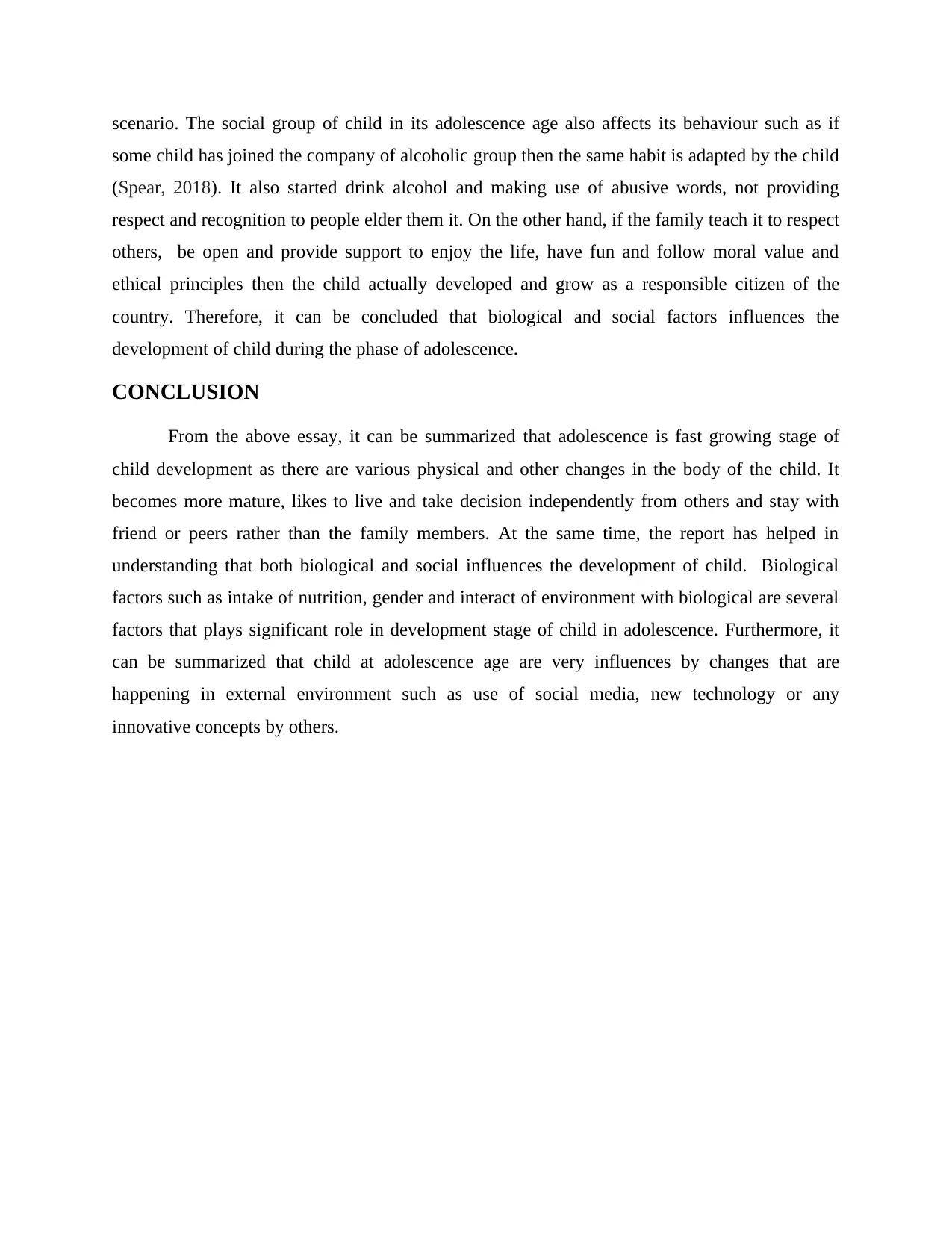
scenario. The social group of child in its adolescence age also affects its behaviour such as if
some child has joined the company of alcoholic group then the same habit is adapted by the child
(Spear, 2018). It also started drink alcohol and making use of abusive words, not providing
respect and recognition to people elder them it. On the other hand, if the family teach it to respect
others, be open and provide support to enjoy the life, have fun and follow moral value and
ethical principles then the child actually developed and grow as a responsible citizen of the
country. Therefore, it can be concluded that biological and social factors influences the
development of child during the phase of adolescence.
CONCLUSION
From the above essay, it can be summarized that adolescence is fast growing stage of
child development as there are various physical and other changes in the body of the child. It
becomes more mature, likes to live and take decision independently from others and stay with
friend or peers rather than the family members. At the same time, the report has helped in
understanding that both biological and social influences the development of child. Biological
factors such as intake of nutrition, gender and interact of environment with biological are several
factors that plays significant role in development stage of child in adolescence. Furthermore, it
can be summarized that child at adolescence age are very influences by changes that are
happening in external environment such as use of social media, new technology or any
innovative concepts by others.
some child has joined the company of alcoholic group then the same habit is adapted by the child
(Spear, 2018). It also started drink alcohol and making use of abusive words, not providing
respect and recognition to people elder them it. On the other hand, if the family teach it to respect
others, be open and provide support to enjoy the life, have fun and follow moral value and
ethical principles then the child actually developed and grow as a responsible citizen of the
country. Therefore, it can be concluded that biological and social factors influences the
development of child during the phase of adolescence.
CONCLUSION
From the above essay, it can be summarized that adolescence is fast growing stage of
child development as there are various physical and other changes in the body of the child. It
becomes more mature, likes to live and take decision independently from others and stay with
friend or peers rather than the family members. At the same time, the report has helped in
understanding that both biological and social influences the development of child. Biological
factors such as intake of nutrition, gender and interact of environment with biological are several
factors that plays significant role in development stage of child in adolescence. Furthermore, it
can be summarized that child at adolescence age are very influences by changes that are
happening in external environment such as use of social media, new technology or any
innovative concepts by others.
Paraphrase This Document
Need a fresh take? Get an instant paraphrase of this document with our AI Paraphraser

REFERENCES
Books and Journals
Blakemore, S .J., 2018. Avoiding social risk in adolescence. Current directions in psychological
science, 27(2). pp.116-122.
Borghuis, J and et.al., 2017. Big Five personality stability, change, and codevelopment across
adolescence and early adulthood. Journal of Personality and Social Psychology, 113(4).
p.641.
Dahl, R. E and et.al., 2018. Importance of investing in adolescence from a developmental
science perspective. Nature, 554(7693). pp.441-450.
Foulkes, L. and Blakemore, S. J., 2018. Studying individual differences in human adolescent
brain development. Nature neuroscience, 21(3).pp.315-323.
Haraden, D. A., Mullin, B. C. and Hankin, B. L., 2017. The relationship between depression and
chronotype: A longitudinal assessment during childhood and adolescence. Depression and
anxiety, 34(10). pp.967-976.
Sawyer, S. M and et.al., 2018. The age of adolescence. The Lancet Child & Adolescent
Health, 2(3). pp.223-228.
Scott, H., Biello, S. M. and Woods, H. C., 2019. Identifying drivers for bedtime social media use
despite sleep costs: the adolescent perspective. Sleep health, 5(6). pp.539-545.
Spear, L. P., 2018. Effects of adolescent alcohol consumption on the brain and behaviour. Nature
Reviews Neuroscience, 19(4). pp.197-214.
Wikle, J. S. and Hoagland, A., 2020. Adolescent interactions with family and emotions during
interactions: Variation by family structure. Journal of Family Psychology, 34(5). p.544.
Worthman, C. M. and Trang, K., 2018. Dynamics of body time, social time and life history at
adolescence. Nature, 554(7693). pp.451-457.
Books and Journals
Blakemore, S .J., 2018. Avoiding social risk in adolescence. Current directions in psychological
science, 27(2). pp.116-122.
Borghuis, J and et.al., 2017. Big Five personality stability, change, and codevelopment across
adolescence and early adulthood. Journal of Personality and Social Psychology, 113(4).
p.641.
Dahl, R. E and et.al., 2018. Importance of investing in adolescence from a developmental
science perspective. Nature, 554(7693). pp.441-450.
Foulkes, L. and Blakemore, S. J., 2018. Studying individual differences in human adolescent
brain development. Nature neuroscience, 21(3).pp.315-323.
Haraden, D. A., Mullin, B. C. and Hankin, B. L., 2017. The relationship between depression and
chronotype: A longitudinal assessment during childhood and adolescence. Depression and
anxiety, 34(10). pp.967-976.
Sawyer, S. M and et.al., 2018. The age of adolescence. The Lancet Child & Adolescent
Health, 2(3). pp.223-228.
Scott, H., Biello, S. M. and Woods, H. C., 2019. Identifying drivers for bedtime social media use
despite sleep costs: the adolescent perspective. Sleep health, 5(6). pp.539-545.
Spear, L. P., 2018. Effects of adolescent alcohol consumption on the brain and behaviour. Nature
Reviews Neuroscience, 19(4). pp.197-214.
Wikle, J. S. and Hoagland, A., 2020. Adolescent interactions with family and emotions during
interactions: Variation by family structure. Journal of Family Psychology, 34(5). p.544.
Worthman, C. M. and Trang, K., 2018. Dynamics of body time, social time and life history at
adolescence. Nature, 554(7693). pp.451-457.
1 out of 8
Related Documents
Your All-in-One AI-Powered Toolkit for Academic Success.
+13062052269
info@desklib.com
Available 24*7 on WhatsApp / Email
![[object Object]](/_next/static/media/star-bottom.7253800d.svg)
Unlock your academic potential
Copyright © 2020–2025 A2Z Services. All Rights Reserved. Developed and managed by ZUCOL.





